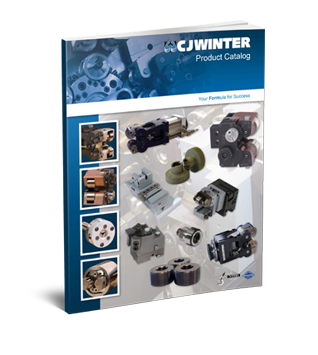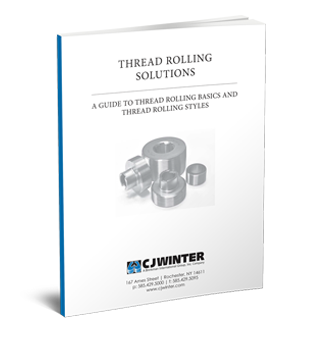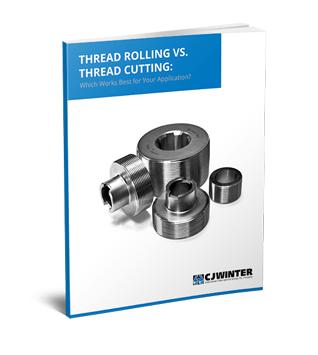Common Threading Problems that Can Occur
CJWinter has identified and solved thread rolling problems of all types over its 60+ year course.
From slivers and flakes to scuffed crests, you can find the solution to your thread rolling issue here. Click on your problem below to learn more about its cause and solution. Can’t find the information you’re looking for? Our team is more than happy to help — contact us today.
Slivers or Flakes on Threads
Problem | Solution |
|---|---|
Rolls not in match | Resynchronize rolls |
Center line of rolls not parallel with center line of work | Check slide for alignment |
Loose or worn cross slide or adapter | Check slide gib and springs. Tighten adapter if used. |
Overfilling rolls | Reduce blank diameter |
Material not adaptable to cold-working | Change material. Check with material supplier. |
Rough finish on blank | Regrind tooling |
Seamy stock | Not suitable for roll threading |
Feed rate too slow, causing rolls to slip on work | Increase rate of penetration |
Incorrect roll diameter | Use correct rolls for job |
Drunken Threads
Problem | Solution |
|---|---|
Rolls not in match | Resynchronize rolls |
Center line of rolls not parallel with center line of work | Check slide for alignment |
Inaccurate rolls | Replace rolls |
Work bending during rolling. | Support part during rolling operation or slow down penetration rate if possible |
Off-Size Threads
Off-Size Threads | Problem | Solution |
|---|---|---|
Pitch diameter and major diameter, both oversize | Oversize blanks | Reduce blank diameter |
Pitch diameter oversize, major diameter correct | Oversize blanks. If finished thread is full, thread on roll is too shallow. | Use correct rolls for job |
Pitch diameter oversize, major diameter undersize | Insufficient penetration on rolls. If finished thread is full, thread on roll is too shallow. | Increase roll penetration |
Pitch diameter correct, major diameter oversize | Blank too large. Thread on roll deeper than necessary. | Reduce blank diameter |
Pitch diameter correct size, major diameter undersize | Blank too small. If finished thread is full, thread on roll is too shallow. | Increase blank diameter. Use correct rolls for job |
Pitch diameter undersize, major diameter oversize | Excessive penetration. Thread on roll deeper than necessary. | Reduce roll penetration. Use correct rolls for job. |
Pitch diameter undersize, major diameter correct size | Blank too small. Thread on roll deeper than necessary. | Increase blank diameter. Use correct rolls for job. |
Pitch diameter and major diameter both undersize | Blank too small | Increase blank diameter |
Out-of-round Thread
Problem | Solution |
|---|---|
Out of round blank | Shave tool not reaching center or not cleaning up rough form diameter |
Center line of rolls not parallel with center line of work | Check slide for alignment |
Feed rate too high | Reduce rate of penetration |
Insufficient work revolutions | Reduce rate of penetration |
Material not ductile enough for cold-working | Change material. Check with supplier. |
Attachment not on center line of work | Reset cross slide with gauge |
Tapered Threads
Tapered Threads | Problem | Solution |
|---|---|---|
Pitch diameter straight.
Major diameter tapered
and not filled on small end | Tapered blank | Straighten blank |
Pitch diameter and major
diameter both tapered
same way | Tapered blank | Straighten blank |
Pitch diameter and major
diameter tapered in opposite directions and thread not filled out on end with small major diameter | Rolls not penetrating deep enough on edge with large pitch diameter and small major diameter, or work bending during rolling | Support part during rolling. Part deflecting out of contact with center of rolls. |
Thread with expanded lead | Expanded lead in rolls | Use correct rolls |
Thread with expanded lead | Material extruding on short length of blank | Use longer blank and remove excess in another position |
Thread with contracted lead | Contracted lead in rolls | Use correct rolls for job |
Poor thread form | Work bending during rolling | Support part during rolling |
Poor thread form | Rolls not in match | Resynchronize rolls |
Poor thread form | Too many work revolutions | Increase rate of roll penetration |
Poor thread form | Center line of rolls not parallel with center line of work | Check slide for alignment |
Thread filled out in center,
but not towards ends,
or vice versa | Blank with varying diameter from end to end | Check blank for taper or shave tool not reaching center |
Thread filled out in center,
but not towards ends,
or vice versa | Center line of rolls not parallel with center line of work | Check slide for alignment |
Poor finish on thread | Overfilling rolls | Check blank diameter oversize. |
Poor finish on thread | Rolls not synchronized. | Resynchronize thread rolls. |
Poor finish on thread | Material accumulated in threads on roll. | Replace rolls if material cannot be removed. |
Poor finish on thread | Material not ductile enough for cold-working. | Change material. |
Poor finish on thread | Chips, from other operations, between rolls and work. | Make sure a good jet of clean oil is reaching rolling position |
Poor finish on thread | Correspondingly poor finish on rolls. | Replace rolls. |
Poor finish on thread | Rolls that are work or broken | Replace rolls |
Split Thread-axially
Problem | Solution |
|---|---|
Seamy stock | Change stock |
Mark from shave tool or hollow mill | Regrind tooling |
Crests Not Filled Out
Problem | Solution |
|---|---|
Blank too small | Increase blank diameter |
Thread on roll too deep | Replace rolls with rolls of correct depth for job. NOTE: Special truncated rolls are available from Winter. |
Scuffed Crests
Problem | Solution |
|---|---|
Attachment not retracting fast enough | Increase speed of roll retraction |
Rolls and gear train building | Check gear train, remove any foreign matter |
Rolling not on center line of work | Reset slide with gauge |
Material accumulated in threads on rolls | Check oil jet flowing on rolling position |
Insufficient wall thickness | Machine hole later in operation or use smaller drill |
Improper supporting mandrel | Use proper supporting mandrel |
Feed rate too high, causing too rapid penetration | Slow down penetration rate |
Hollow Work, Hole Enlarged
Problem | Solution |
|---|---|
Material extruding due to insufficient wall thickness. | Use smaller drill before rolling |
Supporting mandrel too tight | Reduce mandrel diameter |
Blank too large on major diameter | Reduce blank diameter |
Feed rate too high causing too rapid penetration. | Slow down rate of penetration |
Hollow Work, Out of Round
Problem | Solution |
|---|---|
Material deforming due to insufficient wall thickness. | Drill later in cycle. |
Feed rate too high causing too rapid penetration. | Slow down rate of penetration. |
Too few work revolutions. | Slow down rate of penetration. |
Hollow Work, Tapered Threads
Problem | Solution |
|---|---|
Uneven and insufficient wall thickness. | Drill later in cycle. |
Improper mandrel not giving support where needed. | Check mandrel for size with hole. |
Feed rate too high causing too rapid penetration. | Slow down rate of penetration. |
Taper of rolls not great enough to compensate for tendency of work to taper. | Use correct rolls for job. |
If you need further assistance, please call us at 585.429.5000, or use our Contact Page to email a description of your problem. For detailed specification on particular Thread Roll Attachments, that information is available online in the Thread Roll Attachments Page. You can also download our Thread Rolling Solutions brochure to help determine correct working face and roll position.
knowledge base
learn more from our blog
AMERICAN STANDARD EXTERNAL TAPER PIPE THREADS
The United States uses ANSI’s American National Standard Pipe Thread Standards to regulate the formation
WHAT IS THREAD ROLLING?
Thread rolling is a metal forging process that forms threads into the mirror image of
TOP 10 THREAD ROLLING PROBLEMS
Most frequently used in the production of threaded rods, bolts, screws, and other metal fasteners, thread




